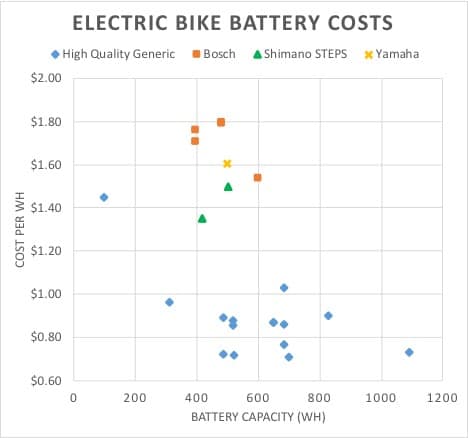Whether you’re planning to buy a new battery for a new electric bike build or replacing an old battery in an existing ebike, knowing the cost of an electric bike battery is key. How much do they cost? Let’s dig into the details.
Typically a new high-quality electric bike battery will cost anywhere between $500 to $900+ depending on the brand and capacity. This would be for a battery with a capacity in the range of 400 wh to 700wh. Name brand battery packs are significantly more expensive when looking at cost per Wh of capacity versus high-quality off-brand battery packs.
Bosch brand battery packs are some of the most expensive, with prices ranging from $675 – $925, with an average cost per Wh of capacity around $1.72/Wh.
Shimano STEPS batteries range in price from $500 – $750, with an average cost per Wh of capacity around $1.42/Wh.
Lastly, off-brand batteries with high-quality cells (Panasonic or Samsung typically, or sometimes LG) have an average cost per Wh of capacity around $0.82/Wh.
The chart below shows the range in cost per Wh of capacity, depending on the brand.

Cheap Price = Cheap Quality
There are many cheaper battery options through direct sellers from China, but these batteries will be of lower quality and can have some of the following issues:
- Unlike Japan or Korea, China is not known for quality 18650 cells
- Many “name brand” cell packs coming from China can actually be made up of clone cells or re-wraps.
- Rewrapped batteries will have bad performance and will not last very long
- Rewrapped or low-quality batteries can also have a higher potential fire hazard.
In this case “Buyer beware” and “you get what you pay for”.
What is in an electric bike battery?
A typical lithium-ion electric bike battery is comprised of two main components – the individual lithium-ion cells and the battery management system.
18650-format Cells
These cells are slightly larger than an AA battery and are named due to their size of 18mm x 65mm. They are used in high-drain devices due to their superior capacity and discharge rates.
Typically these cells will have an average voltage of 3.7v and around 3000-mAh capacity. These cells are then combined in parallel (to increase capacity Ah) and series (to increase Voltage) to create a larger battery suitable for the higher power demand of an electric bike motor.
For example, in a common 48V / 15-Ah pack there would be a total of 65 cells (3.7v, 3000 mAh). These 65 cells would be combined in parallel in groups of 5 to get 15 Ah (3Ah x 5 cells), and these 13 groups of the 3.7v packs would be combined in series to get a nominal 48 V (13 x 3.7v).
In contrast, the most popular battery pack for a Tesla has 7,104 individual 18650 cells!!
Battery Management System (BMS)
The battery management system is the ‘brains’ of the battery, which helps keep the individual sub-packs within a larger battery well balanced to improve the longevity of the battery. It helps with charging (limiting the amount of current) and discharging by limiting the number of amps that can be drawn out of the pack.
Some BMS can also monitor for higher temperatures and limit the battery to prevent overheating and damage to the cells. Some can also connect to your phone via Bluetooth to provide more detailed battery information and have an on/off switch for the battery.
I’ve written about how long a battery will typically last in this post here, but generally, a new battery will last about 1000 charge cycles.
How Do I Replace My bike battery?
Many manufacturers provide replacement batteries for there bikes, which is important to consider when shopping for an ebike is how easy it is to replace the battery. Some batteries are built into the frame and take quite a bit of work to remove and replace. Others simply clip out of the frame or rear rack and a new one put in its place quite easily.
This is one disadvantage to a purpose-built ebike – you are generally tied to the manufacturers battery replacement pack, which is generally quite a bit more expensive than more generic alternatives. If you build your own electric bike with a conversion kit or assembling the parts yourself, you have a lot more choice in what battery you use, it’s quality, capacity, and ultimately it’s price.
Here are a list of several bike manufacturers’ battery packs and their pricing (check your local dealer or online for the most recent prices).
| Battery Pack | Price Range |
| Bosch PowerPack 400 | $650-$750 |
| Bosch PowerPack 500 | $865-$940 |
| Bosch PowerTube 400 | $700 |
| Bosch PowerTube 500 | $865-890 |
| Bosch PowerTube 625 | $925 |
| Shimano STEPS BT-E8014 Battery, Downtube Mounted, 418 Wh | $565 |
| Shimano STEPS BT-E8020 Battery, Intergated Downtube, 504 Wh | $755 |
| Yamaha E-Bike Battery, 500Wh | $800 |
*Prices estimated as of December 2019
If you’re buying a battery online, remember to account for additional shipping costs. Shipping batteries, especially Lithium-ion batteries is complicated and will usually increase your shipping costs by an additional $40-50 depending on the destination. I’ve written about shipping your own electric bike battery as an option if you plan to take your electric bike on a plane.
Can You Have an old battery “repacked”?
What is “repacking” exactly? Basically, this is when the housing or container holding the old/worn out batteries is kept, but new cells are placed in the old housing. This is done so that you get a “new” battery that fits your bike or built-in battery pack.
There are quite a few forums and sites advertising the possibility of repacking an existing casing to replace an aging or broken battery pack. Several manufacturers discourage this practice like Bosch stating:
High-quality lithium-ion batteries like the Bosch PowerPacks are complex, finely-tuned systems the repair of which requires special expertise and elaborate production facilities. That is why a defective battery must in nearly all cases be replaced.
[1]
Some providers claim they can recondition batteries. Bosch strongly advises against this because the safety and optimum interaction with the Battery Management System cannot be guaranteed in this case. In addition, there is a safety risk and opening or modifying the battery may invalidate warranty claims.
[2]
And their claims and warnings are reasonable I think. To be sure if you undertake this endeavor your warranty if any left will surely be void.
However, since most battery packs only have a 1-year warranty anyway there are a few circumstances where repacking a battery could be an appropriate option:
- You’re really trying to keep costs down, especially if the brand name battery pack replacement is quite expensive
- The model of electric bike you own is no longer supported or it’s hard to get replacement parts. This can happen with outfits that go out of business or with older models
The dangers of repacking a battery
I wouldn’t suggest trying this yourself unless you have the specialty tools, expertise/training, and experience to be confident in a good repair. A few venders I’ve found online which seem to have good feedback at EBR. However, I haven’t personally had experience with any of these companies.
Conclusion
In conclusion, the battery on an electric bike is one of the most expensive components to replace, but skimping on quality and going with a cheaper option will generally result in lower quality, shorter lifespan of the battery, and lower performance.
The battery on any electric bike will need replacement after some time and use, but if you take care of your battery to extend it’s useful life as long as possible you’ll find shopping for a new ebike battery is a very rare occurrence.
